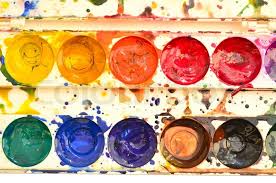When I was a child I had a pallet of watercolors, the ones we all used in grade school. Remember mixing all the colors together so you end up with eight ovals of some kind of brown? Besides tempera paint, watercolors are usually the first experience we have as children. As I got older I forgot about my little pallet and moved on to acrylic paint, the more “grown-up” paint. But then one day a friend of mine back in 8th grade asked me to join her in a watercolor class at the community college. My little pallet of paints just got schooled by the “grown-up” version and oh boy was this exciting. I never knew that various amounts of water could move pigment around the paper. I learned about masking, wet washes, dry brushes, using salt, letting colors bleed together and on and on. I was amazed and delighted. I went home and saved my money to get my first set of Artist Watercolor paints.
I loved the way watercolor paint shows the softer side of subjects. However, I have seen watercolor compositions use bold colors and strokes that I never thought possible. Watercolor is a versatile medium you should consider.
So how do you get started? Let’s talk paper. Watercolor paper comes in three finishes, Rough, Hot Pressed and Cold Pressed. It also comes in large sheets, in pads or journals. Paper can be expensive artist grade or a reasonable price for beginners. I will talk more in-depth about paper and watercolor paper.

| Finish | Properties |
|---|---|
| Rough | Most absorbent.Surface traps watercolor pigments creating an even watercolor wash. Best for dry brush technique. Not great for lifting and corrections. Best suited for aggressive brush techniques. Not for highly detailed works as the surface texture does not allow small details to be painted in the correct shape. Color vibrancy is not the best on rough paper. Works well with all painting consistencies, from very diluted to undiluted. |
| Cold Pressed | Medium absorbency. Washes come out almost as good as rough paper. Dry brush technique works to some extent. Some amount of lifting and corrections can be done. It can take most of the aggressive brush technique well. A good amount of detailed work can also be done on this. The vibrancy of colors is good as long as glazes are kept to a minimum. Works well with all painting consistencies, from very diluted to undiluted. |
| Hot Pressed | This is the least absorbent paper. Washes turn out uneven, but it gives a nice juicy look. Dry brush technique just won’t work on this. Best suited for lifting and corrections. Brushwork has to be light and delicate. Aggressive brush work really does not work on this paper. Best suited for highly detailed work. This is the best paper for retaining the vibrancy of colors. Does not work well with undiluted paint. |
sited from http://prabalmallick.net/blog/watercolour-paper/
 Now for the paint. The sky is the limit. Tubes, pans, swatches, pencils. There are literally thousands of manufactures of watercolor paint, so how do you choose? Price, color selection, quality of the pigment… Find a set of colors that fits your ability and budget, period. Remember you don’t necessarily need 80 colors, you can mix every color you want with red, yellow and blue. Two yellows, two reds, two blues, burnt umber, and black are great to start off with. What about white? If you need a lighter shade of a color just use more water to dilute it and also take advantage of the white paper.
Now for the paint. The sky is the limit. Tubes, pans, swatches, pencils. There are literally thousands of manufactures of watercolor paint, so how do you choose? Price, color selection, quality of the pigment… Find a set of colors that fits your ability and budget, period. Remember you don’t necessarily need 80 colors, you can mix every color you want with red, yellow and blue. Two yellows, two reds, two blues, burnt umber, and black are great to start off with. What about white? If you need a lighter shade of a color just use more water to dilute it and also take advantage of the white paper.
 Get a few brushes. There are brushes made for watercolor, so a round brush a flat and a filbert will do just fine to start out with. You can get brushes in different sizes too. I know it’s overwhelming. Just try out a few or get a small inexpensive set until you find what you like. Again, I can dedicate a whole page to paper, brushes, and paint, which I will in the next few posts. So gather your materials and we’ll get painting!
Get a few brushes. There are brushes made for watercolor, so a round brush a flat and a filbert will do just fine to start out with. You can get brushes in different sizes too. I know it’s overwhelming. Just try out a few or get a small inexpensive set until you find what you like. Again, I can dedicate a whole page to paper, brushes, and paint, which I will in the next few posts. So gather your materials and we’ll get painting!
Artfully yours,
Andi
P.S. I will make some video demonstrations for my next few posts…stay tuned!


This article makes me want to start painting again. I was always partial to oil painting, but maybe I’ve just never given watercolor a shot. Thank you so much for sharing this.
LikeLike